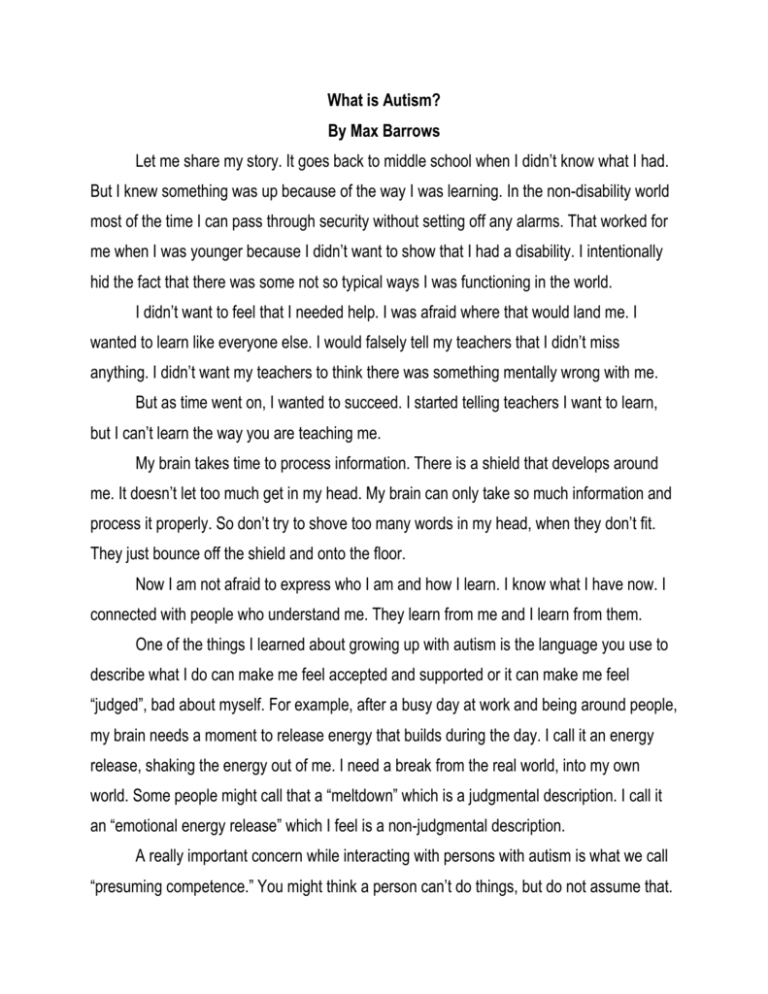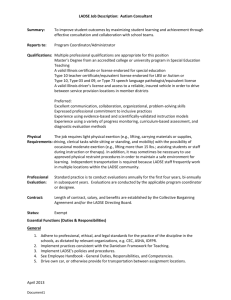What is Autism
advertisement

What is Autism? By Max Barrows Let me share my story. It goes back to middle school when I didn’t know what I had. But I knew something was up because of the way I was learning. In the non-disability world most of the time I can pass through security without setting off any alarms. That worked for me when I was younger because I didn’t want to show that I had a disability. I intentionally hid the fact that there was some not so typical ways I was functioning in the world. I didn’t want to feel that I needed help. I was afraid where that would land me. I wanted to learn like everyone else. I would falsely tell my teachers that I didn’t miss anything. I didn’t want my teachers to think there was something mentally wrong with me. But as time went on, I wanted to succeed. I started telling teachers I want to learn, but I can’t learn the way you are teaching me. My brain takes time to process information. There is a shield that develops around me. It doesn’t let too much get in my head. My brain can only take so much information and process it properly. So don’t try to shove too many words in my head, when they don’t fit. They just bounce off the shield and onto the floor. Now I am not afraid to express who I am and how I learn. I know what I have now. I connected with people who understand me. They learn from me and I learn from them. One of the things I learned about growing up with autism is the language you use to describe what I do can make me feel accepted and supported or it can make me feel “judged”, bad about myself. For example, after a busy day at work and being around people, my brain needs a moment to release energy that builds during the day. I call it an energy release, shaking the energy out of me. I need a break from the real world, into my own world. Some people might call that a “meltdown” which is a judgmental description. I call it an “emotional energy release” which I feel is a non-judgmental description. A really important concern while interacting with persons with autism is what we call “presuming competence.” You might think a person can’t do things, but do not assume that. This is important because while persons with disabilities need support at times, they want to have the opportunity to accomplish things in their lives. Everybody wants to feel confident when it comes to solving problems. For example, it may be easy for you to assume that people who have limited speech don’t put much thought into the world. But using other ways to communicate we can bust that myth. Your first impression might be: this person does not understand, when in reality, they are expressing themselves in a different way. To me, as a person with autism, this disability is NOT a tragedy or something to feel ashamed of. It is who I am and how I experience the world. But each person experiences autism in different ways. There is a popular saying that when you meet a person with autism, you’ve met one person with autism. Here are some ways people experience autism. They may: have trouble speaking; avoid eye contact; have special interests that capture their attention’ be frightened by certain sounds or the way things look; get stuck talking about situations that bothers them or have difficulty reading facial expressions accurately. One of my colleagues, Tracy Thresher said, “I wondered growing up why my body poorly listened to my intentions to move the way I wanted”. I am a fan of the World Health Organization’s definition of disability. A person is more or less disabled based on what they can and cannot do in the many types of environments they encounter. So yes, a person with autism may have trouble speaking, reading facial expressions or organizing their day, but our experience of autism can be decreased by looking at the environment, and having the best accommodations. Persons with autism have different experiences with the environment. For example florescent light bulbs don’t bother me, but I know someone with autism who can’t work with them on. A person’s experience with the environment may change overtime. For me, when I was younger, I found the noises of fire alarms and thunder to be intimidating, but now, they don’t bother me. Thunderstorms and other loud noises today can be positive experiences. For some persons with autism, iPads are used with “text to speak” software to communicate. Kyle Moriarty said, “My autism does not allow me to use my voice, but through supported typing I can get my intelligent thoughts out for everyone to hear. Typing allows me to show the world that I am an intelligent man who has dreams and life goals like any other individual.” People with autism want to be included in life like everyone else and don’t want to be viewed as just our disability. Another colleague, Kris Medina just about makes this point best. “Autism affects my speech and many other components of my life. One thing it doesn’t affect is my ability to dream and work hard to reach my dreams.” Keep this in mind when you interact with persons with disabilities. When it comes to intelligence, everybody is intelligent in their own way. One reason people with disabilities are not included is because people make false assumptions about their abilities to learn and grow. Doug Biklen, of Syracuse University, suggested: “If you want to see competence it helps if you look for it.”







